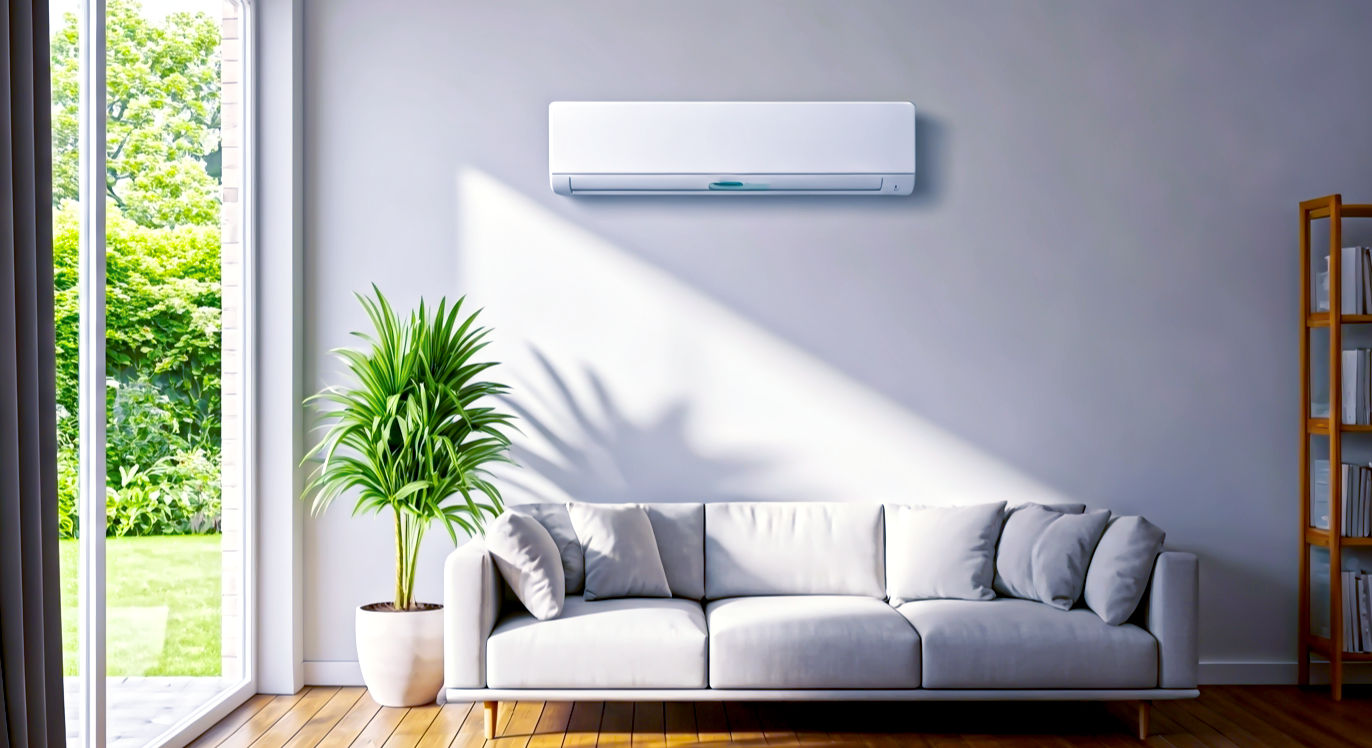The Guide to Choosing the Best Air Conditioner for Your Home in the UK
The complete guide to buying an air conditioner in the UK. We cover portable vs. split systems, BTU calculations, running costs, and planning permission rules.

This post may contain affiliate links. If you make a purchase through these links, we may earn a commission at no additional cost to you.
Let’s be honest, for decades, air conditioning in a British home felt like a bit of a joke. It was something you enjoyed on holiday in Spain or saw in American films. Our summers were, for the most part, mild and manageable. A few hot days were a novelty, an excuse for a 99 Flake and a moan about the heat.
But things are changing. The UK is getting warmer. Summer heatwaves are no longer a surprise; they’re a regular feature. Suddenly, trying to sleep in a stuffy loft bedroom or work from home in a sweltering conservatory isn’t just uncomfortable—it’s unbearable.
This guide is here to cut through the confusion. We’re going to demystify the world of home air conditioning, turning jargon into plain English and giving you the confidence to choose the right solution for your home. Forget the idea that air con is an expensive, planet-hurting luxury. The right system can be an efficient, affordable, and life-changing investment in your comfort and well-being.
Whether you live in a modern city flat, a Victorian terrace, or a new-build semi, we’ll cover everything you need to know to make your home a cool, calm oasis when the next heatwave hits.
Why Even Bother with Air Con in Britain?
It’s a fair question. We’re famous for our grey skies and drizzle, not scorching heat. But the facts speak for themselves. According to the Met Office, the 21st century has been significantly warmer than the 20th, and heatwaves are becoming more intense and frequent. The record-breaking 40°C days we saw in 2022 are a sign of things to come.
Beyond just cooling down, modern air conditioners offer a range of benefits perfect for UK homes:
- They Dehumidify: British homes can get damp and muggy, especially in summer. Air conditioners are brilliant at pulling excess moisture out of the air, which can help prevent mould and create a much more comfortable environment.
- They Filter the Air: If you suffer from hay fever or other allergies, the filters in an air conditioner can be a game-changer. They trap pollen, dust, and other pollutants, improving your indoor air quality.
- They Help You Sleep: Trying to sleep when it’s hot and sticky is miserable. A cool, quiet bedroom is one of the biggest reasons people invest in air con. A good night’s sleep can transform your health and mood.
- They Can Help You Focus: With more of us working from home, a comfortable environment is crucial for productivity. A cool room helps you stay focused and on-task when the temperatures outside are soaring.
So, it’s not about turning your home into a freezer. It’s about taking control of your indoor climate to create a healthier, more comfortable living space.
The A-to-Z of Air Conditioner Types: Finding Your Perfect Match
When you start looking, you’ll find a few different types of air conditioners. Each has its pros and cons, and the right one for you depends on your home, your budget, and what you need it to do.
1. Portable Air Conditioners: The Plug-in-and-Go Option
This is the type most people think of first. It’s a single unit on wheels that you can move from room to room. It works by sucking in hot air, cooling it, and then blowing the cool air back into the room. The heat it removes has to go somewhere, so all portable units have a thick hose that you need to vent out of a window.
- The Good Bits:
- Low Upfront Cost: They are the cheapest type of air conditioner to buy, often starting from around £300.
- No Installation Needed: You just plug it in and stick the hose out of the window. It’s a bit of a faff, but you can do it yourself in minutes.
- Move It Around: Need to cool the living room during the day and the bedroom at night? You can wheel it where you need it.
- The Not-So-Good Bits:
- Noisy: The entire machine, including the noisy compressor, is in the room with you. They can be as loud as a washing machine on a spin cycle, which isn’t ideal for light sleepers.
- Inefficient: Because you have to have a window open for the hose, you’re constantly letting warm air back in. It’s a bit like trying to heat your house with the front door open. Look for dual-hose models if you can—they are a bit more efficient as one hose draws air from outside and the other vents the hot air out.
- Bulky and Heavy: They take up a fair bit of floor space, and while they have wheels, lugging one upstairs isn’t much fun.
- The Hose Problem: The window kits they come with are often flimsy and designed for American-style sash windows, not the casement windows common in the UK.
Who are they for? Portable units are a great choice for renters who can’t make permanent changes, or for people who only need occasional cooling for a single room and are on a tight budget.
2. Split-System Air Conditioners: The Quiet, Powerful Choice
A split system is what you probably imagine when you think of “proper” air conditioning. It has two parts: an indoor unit that’s usually mounted high on a wall, and an outdoor unit that contains the noisy compressor. The two are connected by pipes that run through the wall.
- The Good Bits:
- Whisper Quiet: Because the noisy part is outside, the indoor units are incredibly quiet, making them perfect for bedrooms and living rooms.
- Very Efficient: They cool a room much more effectively and use less energy than a portable unit because the system is completely sealed.
- Powerful: They come in a huge range of sizes and can cool even very large, open-plan spaces.
- Neat and Tidy: The indoor unit is discreet and out of the way, with no floor space taken up and no hoses to worry about.
- Multi-Split Options: You can connect multiple indoor units to a single outdoor unit, allowing you to cool several rooms independently.
- The Not-So-Good Bits:
- High Upfront Cost: This is a much bigger investment. A single unit can cost from £1,500 to £3,000 or more, including professional installation.
- Professional Installation is a Must: You can’t fit these yourself. The system contains refrigerant gases, so by law, it must be installed by an F-Gas registered engineer.
- It’s a Fixture: Once it’s installed, it’s there to stay. This is a permanent alteration to your home.
Who are they for? Homeowners who are looking for a powerful, efficient, and long-term solution for one or more rooms. They are the best choice for serious, regular cooling.
3. Window Air Conditioners: A Rare Sight in the UK
A window unit is an all-in-one box that sits in an open window, with the cold side facing in and the hot side facing out. They are hugely popular in the US but are less common here.
- The Good Bits:
- Cheaper than a Split System: They offer better performance than a portable unit for less money than a full split system.
- Relatively Easy to Install: They don’t require specialist engineers, but you do need a suitable window (usually a sash window) and the skills to secure it safely.
- The Not-So-Good Bits:
- Doesn’t Fit Most UK Windows: The vast majority of British homes have casement windows that swing outwards, which just don’t work with these units.
- Security Risk: It can make your window less secure.
- Noisy: Like a portable unit, the whole mechanism is in one box, so it can be quite loud.
Who are they for? Realistically, very few people in the UK. You’d need the right type of window and be happy with the trade-offs.
Decoding the Jargon: What Do All the Numbers Mean?
Buying an air conditioner can feel like you need a science degree. All those acronyms and numbers can be confusing, but there are really only three you need to understand.
BTU: The Measure of Cooling Power
BTU stands for British Thermal Unit. It’s a measure of heat, and for an air conditioner, it tells you how much heat it can remove from a room in an hour. Put simply, a bigger BTU number means more cooling power.
Getting the right BTU for your room size is the most important step.
- Too low a BTU, and the unit will run constantly without ever properly cooling the room. It’s like trying to bail out a boat with a teaspoon.
- Too high a BTU, and the unit will cool the room too quickly and switch off. This sounds good, but it won’t have run long enough to dehumidify the air properly, leaving you with a room that feels cold and clammy.
How to Calculate the Right BTU for Your Room
There’s a simple formula to get a good estimate. First, you need your room size in square metres.
- Measure the length and width of your room in metres.
- Multiply them together to get the area in square metres (m²).
- Multiply the area by 500.
(Room Length in m x Room Width in m) x 500 = Recommended BTU
But wait! You need to adjust this for your room’s conditions:
- Is it a very sunny, south-facing room? Add 10% to your BTU figure.
- Is it a kitchen with heat-generating appliances? Add 4,000 BTU.
- Are there more than two people regularly in the room? Add 600 BTU for each extra person.
- Is it a poorly insulated space like a conservatory or a loft conversion? You might need to add 20-30%.
Here’s a quick reference guide for standard rooms:
| Room Size (m²) | Example Room Type | Recommended BTU |
|---|---|---|
| Up to 18 m² | Small Bedroom / Home Office | 5,000 – 7,000 |
| 18 m² to 25 m² | Double Bedroom / Small Lounge | 7,000 – 9,000 |
| 25 m² to 35 m² | Large Lounge / Master Bedroom | 9,000 – 12,000 |
| 35 m² to 50 m² | Large Open-Plan Living Area | 12,000 – 18,000 |
EER & Energy Labels: The Efficiency Score
EER stands for Energy Efficiency Ratio. It’s a number that tells you how much cooling you get for each unit of electricity you use. A higher EER is better.
You’re probably already familiar with the A-G energy labels on fridges and washing machines. Air conditioners use the same system. An ‘A’ rated model will have a high EER and will be cheaper to run than a ‘G’ rated model with the same BTU. It’s always worth paying a little more upfront for a more efficient model, as it will save you money on your electricity bills in the long run.
Noise Levels (dB): The Sanity Saver
The noise an air conditioner makes is measured in decibels (dB). This is a hugely important factor, especially for a unit you want to use in your bedroom. A small difference in dB can mean a big difference in how loud it sounds.
Here’s a rough guide:
- 30 dB: A whisper
- 40 dB: A quiet library
- 50 dB: A quiet conversation, a modern fridge
- 60 dB: A normal conversation, a dishwasher
- 70 dB: A vacuum cleaner
Portable units often run at 50-65 dB, which can be very intrusive. A good split system, on the other hand, can be as quiet as 20-25 dB on its lowest setting—practically silent. Always check the dB rating before you buy.
The Big Question: How Much Will It Actually Cost?
There are two costs to consider: the price of the unit itself and how much it will cost to run.
1. Upfront Costs
- Portable Air Conditioners: £300 – £800. More expensive models might be quieter, more efficient, or have smart features.
- Window Air Conditioners: £400 – £900. (If you can find one that fits).
- Split-System Air Conditioners (including installation): £1,500 – £3,000 for a single indoor unit. A multi-split system for several rooms could cost £4,000 or more. The final price depends on the power of the unit and the complexity of the installation.
2. Running Costs
This is where people get nervous, but it’s often cheaper than you think. The cost to run an air conditioner depends on three things:
- The power of the unit (in kilowatts, kW).
- How many hours you use it.
- The price you pay for electricity (in pence per kilowatt-hour, p/kWh).
You can find the power consumption in kW on the unit’s energy label. As of early 2025, the average price for electricity in the UK is around 25p/kWh.
Here’s the simple formula:
Power (kW) x Hours of Use x Electricity Price (p/kWh) = Total Cost
Let’s look at an example. You buy a 1.0 kW portable air conditioner (a typical size) and use it for 4 hours in the evening.
1.0 kW x 4 hours x £0.25/kWh = £1.00
So, it would cost about a pound to cool your room for the whole evening. A more efficient 0.7 kW split system doing the same job might only cost:
0.7 kW x 4 hours x £0.25/kWh = £0.70
Over a whole summer, that efficiency really adds up. Don’t be scared by horror stories of massive bills—used sensibly, air conditioning is perfectly affordable.
Installation: The DIY vs. Pro Dilemma
How your air conditioner is installed is just as important as which one you buy.
Portable and Window Units
This is a DIY job. For a portable unit, you’ll need to set up the window venting kit. Be prepared to get creative with foam board and tape to create a good seal around the hose, especially with UK casement windows. This makes a huge difference to its efficiency.
Split Systems: Call in the Experts
This is not a DIY job. We can’t stress this enough. Split systems use refrigerant gases that are harmful to the environment if they leak. UK law states that only F-Gas registered engineers are allowed to install, maintain, or service them.
- Always check that your installer is on the F-Gas Register.
- A professional installation ensures the system runs safely, efficiently, and doesn’t invalidate your warranty.
- The installer will find the best spot for both the indoor and outdoor units, drill a neat hole through the wall, connect the pipes, and make sure everything is sealed and working perfectly.
Do I Need Planning Permission?
This is a common worry, but the rules are quite straightforward.
- For portable units: No, you don’t need any permission at all.
- For split systems: In most cases, installing an air conditioner falls under Permitted Development Rights, which means you don’t need to apply for planning permission.
However, you might need permission if:
- You live in a listed building or a conservation area.
- The outdoor unit would be on the front of your house, facing a road.
- The outdoor unit is very large or noisy.
- You live in a flat, in which case you will almost certainly need permission from the freeholder or management company.
The golden rule is: if in doubt, check with your local council’s planning department. A quick phone call can save you a lot of trouble later.
Beyond Cooling: Extra Features to Look For
Modern air conditioners come with a host of clever features that can make them even more useful.
- Heating Mode: Many split systems are actually heat pumps, meaning they can run in reverse to provide very efficient heating in the winter. It’s like getting two appliances in one.
- Dehumidifier-Only Mode: A great feature for damp British days, even when it’s not hot. It runs the unit at a low power setting just to pull moisture from the air.
- Smart Control: Many new models can connect to your Wi-Fi, allowing you to control them from an app on your phone. You can turn the AC on before you get home from work so the house is cool when you arrive.
- Timer: Lets you set the unit to turn on or off at specific times, saving energy.
- Sleep Mode: Gradually increases the temperature throughout the night and runs the fan at its quietest speed for a peaceful night’s sleep.
- Advanced Filters: Look for models with HEPA filters or other air purification technologies if allergies or air quality are a major concern for you.
Our Final Word: Is Air Conditioning Worth It in the UK?
For a growing number of us, the answer is a resounding yes.
Our climate is changing, and the discomfort of overheated homes is becoming a serious issue affecting our sleep, health, and productivity. An air conditioner is no longer an exotic luxury; it’s a practical tool for creating a comfortable modern home.
The key is to choose wisely. Don’t just rush out and buy the cheapest portable unit you can find.
- Assess your needs: How many rooms do you need to cool? How important are noise and efficiency?
- Calculate your BTU: Measure your room and do the sums to ensure you get the right size unit.
- Set your budget: Factor in both the purchase price and the running costs.
- Plan the installation: Decide if a DIY portable unit will do the job, or if you need to invest in a professionally installed split system.
By investing in the right system, you’re not just buying a machine; you’re buying cool, quiet nights, comfortable living spaces, and a welcome retreat from the increasingly hot British summers.
Further Reading & Resources
For those looking to dive deeper, these resources provide reliable, expert information:
- The F-Gas Register: The official register to find a legally certified engineer to install a split-system air conditioner in the UK.
- Met Office – UK Climate Change: Data and articles on how and why the UK’s climate is warming.
- Ofgem – Energy Price Cap: The source for current energy price information to help you accurately calculate running costs.
- Planning Portal: The UK government’s official online planning and building regulations resource, useful for checking rules on permitted development for outdoor units.
- Which? Air Conditioner Reviews: The highly respected UK consumer champion, offering impartial reviews and buying advice (may require a subscription).






